Organisational Behaviour Report: Tesco, Leadership & Culture
VerifiedAdded on 2021/02/20
|18
|4863
|53
Report
AI Summary
This report provides an in-depth analysis of Tesco's organisational behaviour, examining the impact of culture, politics, and power on individuals and teams. It explores the application of Handy's model to understand Tesco's culture, and how politics and power dynamics influence the workplace. The report evaluates content and process theories of motivation, including Maslow's hierarchy of needs, Herzberg's two-factor theory, and Vroom's expectancy theory, and how Tesco utilizes these theories to achieve its objectives. It also differentiates between effective and ineffective teams, potentially referencing the Belbin model, and concludes by applying concepts and philosophies of organisational behaviour to the organisation, demonstrating different leadership styles and their impact on the company's performance. The report leverages the understanding of how globalisation and digital technology have influenced Tesco's business operations and organizational culture.
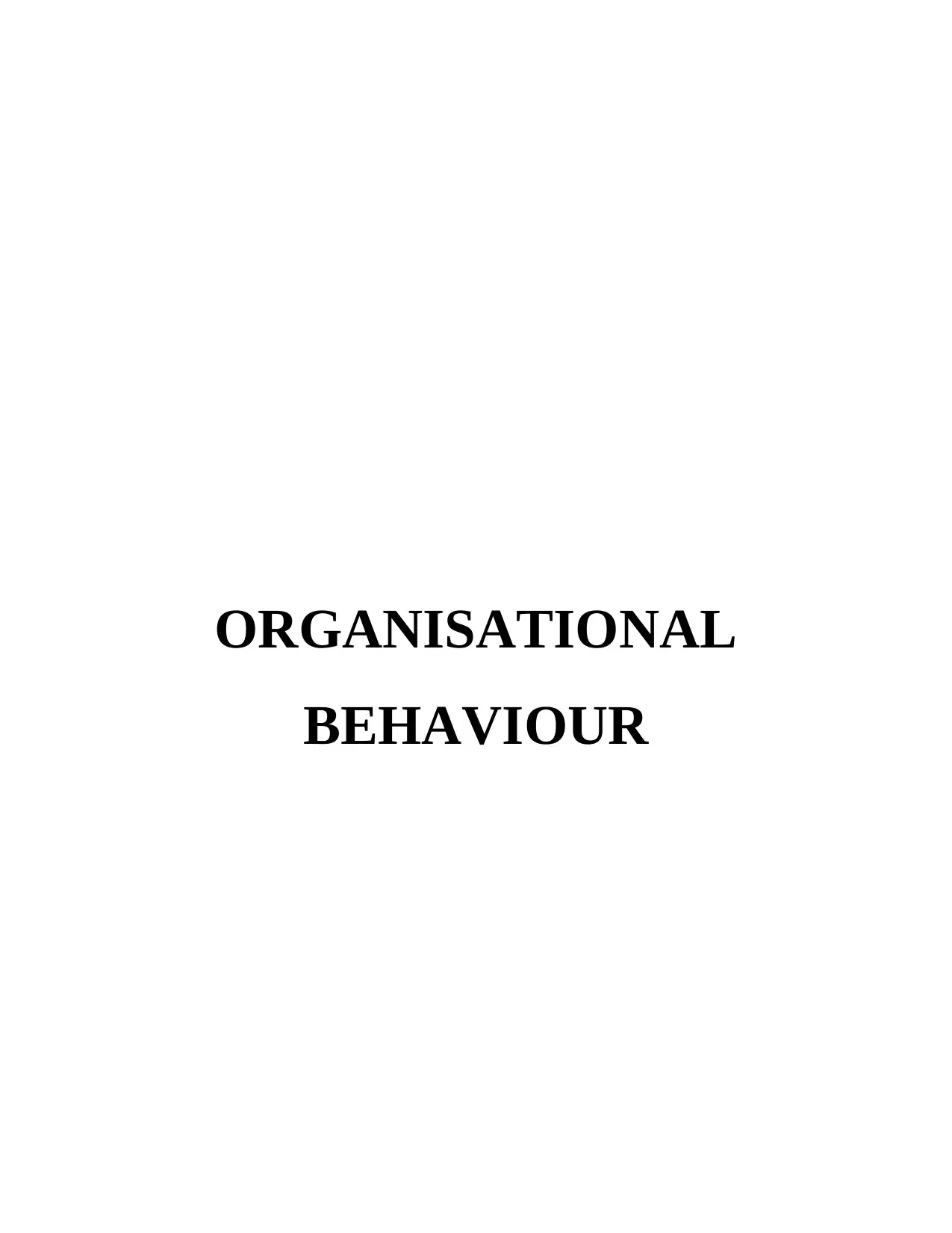
ORGANISATIONAL
BEHAVIOUR
BEHAVIOUR
Paraphrase This Document
Need a fresh take? Get an instant paraphrase of this document with our AI Paraphraser
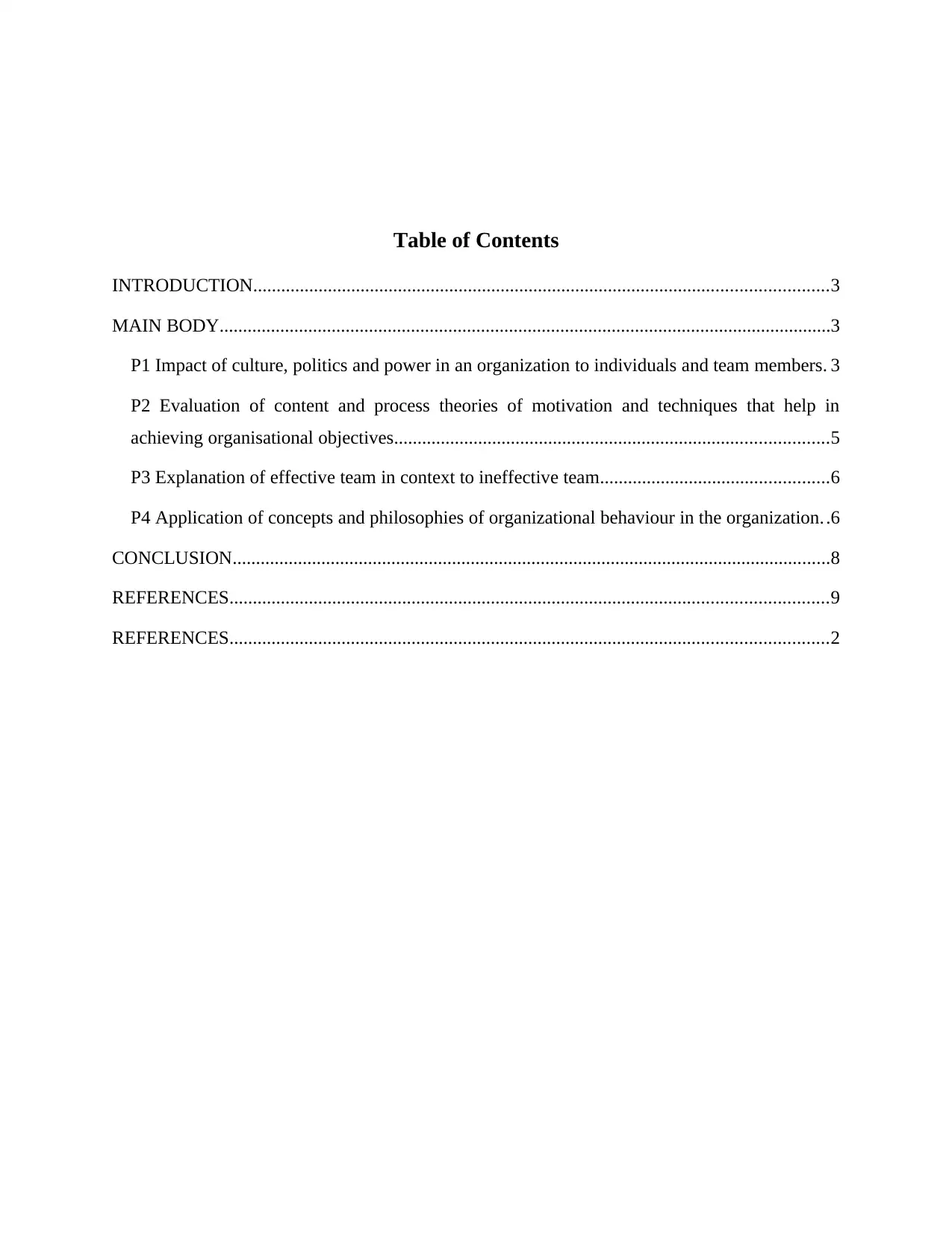
Table of Contents
INTRODUCTION...........................................................................................................................3
MAIN BODY...................................................................................................................................3
P1 Impact of culture, politics and power in an organization to individuals and team members. 3
P2 Evaluation of content and process theories of motivation and techniques that help in
achieving organisational objectives.............................................................................................5
P3 Explanation of effective team in context to ineffective team.................................................6
P4 Application of concepts and philosophies of organizational behaviour in the organization..6
CONCLUSION................................................................................................................................8
REFERENCES................................................................................................................................9
REFERENCES................................................................................................................................2
INTRODUCTION...........................................................................................................................3
MAIN BODY...................................................................................................................................3
P1 Impact of culture, politics and power in an organization to individuals and team members. 3
P2 Evaluation of content and process theories of motivation and techniques that help in
achieving organisational objectives.............................................................................................5
P3 Explanation of effective team in context to ineffective team.................................................6
P4 Application of concepts and philosophies of organizational behaviour in the organization..6
CONCLUSION................................................................................................................................8
REFERENCES................................................................................................................................9
REFERENCES................................................................................................................................2
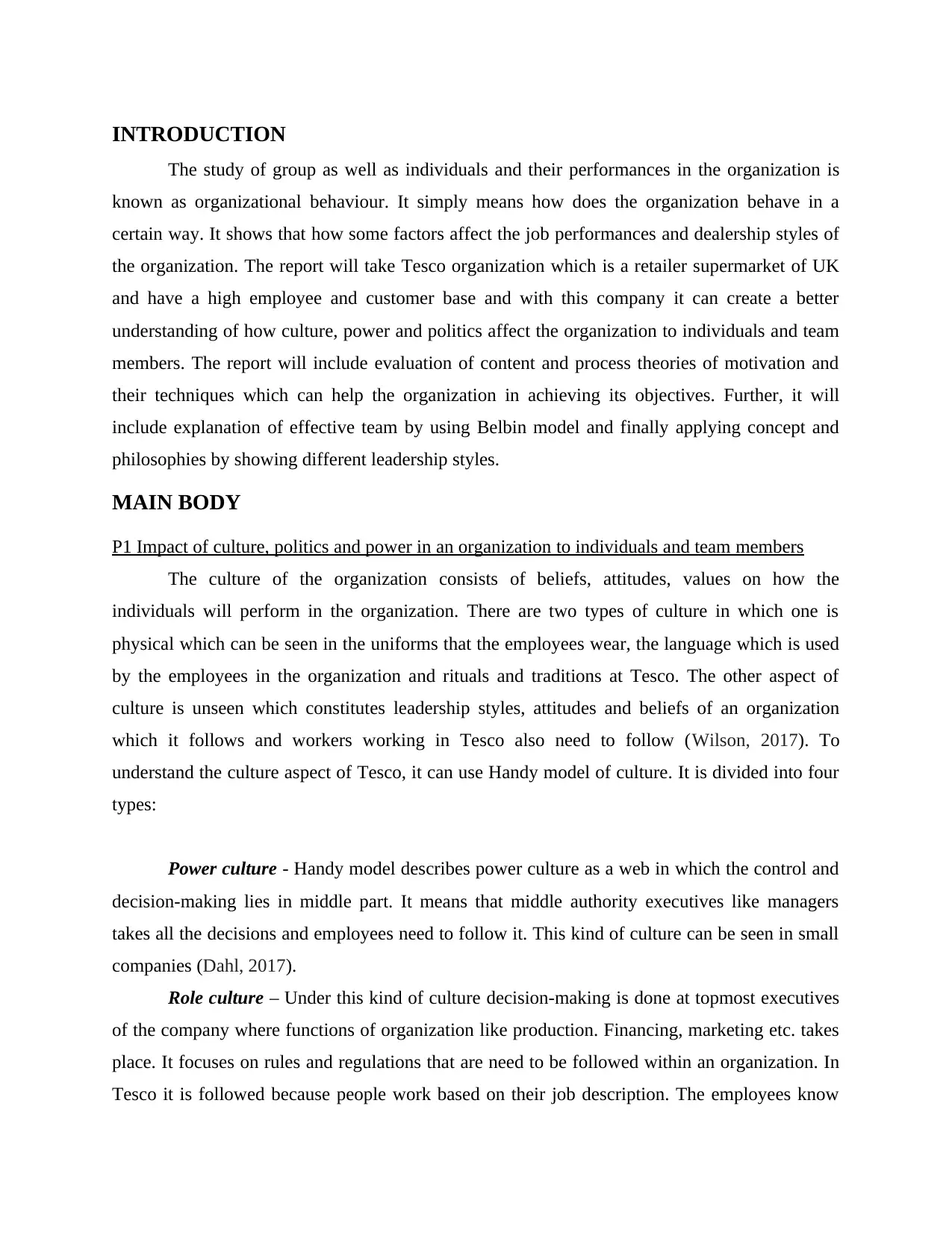
INTRODUCTION
The study of group as well as individuals and their performances in the organization is
known as organizational behaviour. It simply means how does the organization behave in a
certain way. It shows that how some factors affect the job performances and dealership styles of
the organization. The report will take Tesco organization which is a retailer supermarket of UK
and have a high employee and customer base and with this company it can create a better
understanding of how culture, power and politics affect the organization to individuals and team
members. The report will include evaluation of content and process theories of motivation and
their techniques which can help the organization in achieving its objectives. Further, it will
include explanation of effective team by using Belbin model and finally applying concept and
philosophies by showing different leadership styles.
MAIN BODY
P1 Impact of culture, politics and power in an organization to individuals and team members
The culture of the organization consists of beliefs, attitudes, values on how the
individuals will perform in the organization. There are two types of culture in which one is
physical which can be seen in the uniforms that the employees wear, the language which is used
by the employees in the organization and rituals and traditions at Tesco. The other aspect of
culture is unseen which constitutes leadership styles, attitudes and beliefs of an organization
which it follows and workers working in Tesco also need to follow (Wilson, 2017). To
understand the culture aspect of Tesco, it can use Handy model of culture. It is divided into four
types:
Power culture - Handy model describes power culture as a web in which the control and
decision-making lies in middle part. It means that middle authority executives like managers
takes all the decisions and employees need to follow it. This kind of culture can be seen in small
companies (Dahl, 2017).
Role culture – Under this kind of culture decision-making is done at topmost executives
of the company where functions of organization like production. Financing, marketing etc. takes
place. It focuses on rules and regulations that are need to be followed within an organization. In
Tesco it is followed because people work based on their job description. The employees know
The study of group as well as individuals and their performances in the organization is
known as organizational behaviour. It simply means how does the organization behave in a
certain way. It shows that how some factors affect the job performances and dealership styles of
the organization. The report will take Tesco organization which is a retailer supermarket of UK
and have a high employee and customer base and with this company it can create a better
understanding of how culture, power and politics affect the organization to individuals and team
members. The report will include evaluation of content and process theories of motivation and
their techniques which can help the organization in achieving its objectives. Further, it will
include explanation of effective team by using Belbin model and finally applying concept and
philosophies by showing different leadership styles.
MAIN BODY
P1 Impact of culture, politics and power in an organization to individuals and team members
The culture of the organization consists of beliefs, attitudes, values on how the
individuals will perform in the organization. There are two types of culture in which one is
physical which can be seen in the uniforms that the employees wear, the language which is used
by the employees in the organization and rituals and traditions at Tesco. The other aspect of
culture is unseen which constitutes leadership styles, attitudes and beliefs of an organization
which it follows and workers working in Tesco also need to follow (Wilson, 2017). To
understand the culture aspect of Tesco, it can use Handy model of culture. It is divided into four
types:
Power culture - Handy model describes power culture as a web in which the control and
decision-making lies in middle part. It means that middle authority executives like managers
takes all the decisions and employees need to follow it. This kind of culture can be seen in small
companies (Dahl, 2017).
Role culture – Under this kind of culture decision-making is done at topmost executives
of the company where functions of organization like production. Financing, marketing etc. takes
place. It focuses on rules and regulations that are need to be followed within an organization. In
Tesco it is followed because people work based on their job description. The employees know
⊘ This is a preview!⊘
Do you want full access?
Subscribe today to unlock all pages.

Trusted by 1+ million students worldwide

their job role and know what is required to them for completing their job. They follow rules and
regulations of Tesco as it is important for the staff to do that in order to achieve cooperation and
coordination.
Task culture – It focuses on employees working together within an organization that are
working together as a team to achieve the goals of the organization. It focuses on decision
making within a team and members of the team. The organization that follows task culture is
Blackberry as they work in a team to ensure that employees introduce new features and ideas for
customers.
Person culture – The person culture focuses on individuals which is the focus of
organisation who is interested in the job. This culture is followed by doctors as their main focus
is on individuals around them.
With the help of Handy's model that Tesco can follow the mix of culture contained in
Handy model in which on the shop floor the employees can be assigned duties and need to
follow role culture so that they can be focused on what they want to do and what are their job
descriptions. This includes supervisors and checkout operators. The power culture of the
company can be suited to chief executives of Tesco who are at higher position in hierarchy
because they have to make important decisions and have control over the company.
Politics in organization
Politics is the potential force that can be applied in the organization when used effective
and can help the company in achieving its values and objectives. Organizational politics include
various activities which is aligned with the use of tactics and strategies to improve performances
of the organization. The politics in Tesco can either have positive or negative impact. There are
regulations of Tesco as it is important for the staff to do that in order to achieve cooperation and
coordination.
Task culture – It focuses on employees working together within an organization that are
working together as a team to achieve the goals of the organization. It focuses on decision
making within a team and members of the team. The organization that follows task culture is
Blackberry as they work in a team to ensure that employees introduce new features and ideas for
customers.
Person culture – The person culture focuses on individuals which is the focus of
organisation who is interested in the job. This culture is followed by doctors as their main focus
is on individuals around them.
With the help of Handy's model that Tesco can follow the mix of culture contained in
Handy model in which on the shop floor the employees can be assigned duties and need to
follow role culture so that they can be focused on what they want to do and what are their job
descriptions. This includes supervisors and checkout operators. The power culture of the
company can be suited to chief executives of Tesco who are at higher position in hierarchy
because they have to make important decisions and have control over the company.
Politics in organization
Politics is the potential force that can be applied in the organization when used effective
and can help the company in achieving its values and objectives. Organizational politics include
various activities which is aligned with the use of tactics and strategies to improve performances
of the organization. The politics in Tesco can either have positive or negative impact. There are
Paraphrase This Document
Need a fresh take? Get an instant paraphrase of this document with our AI Paraphraser
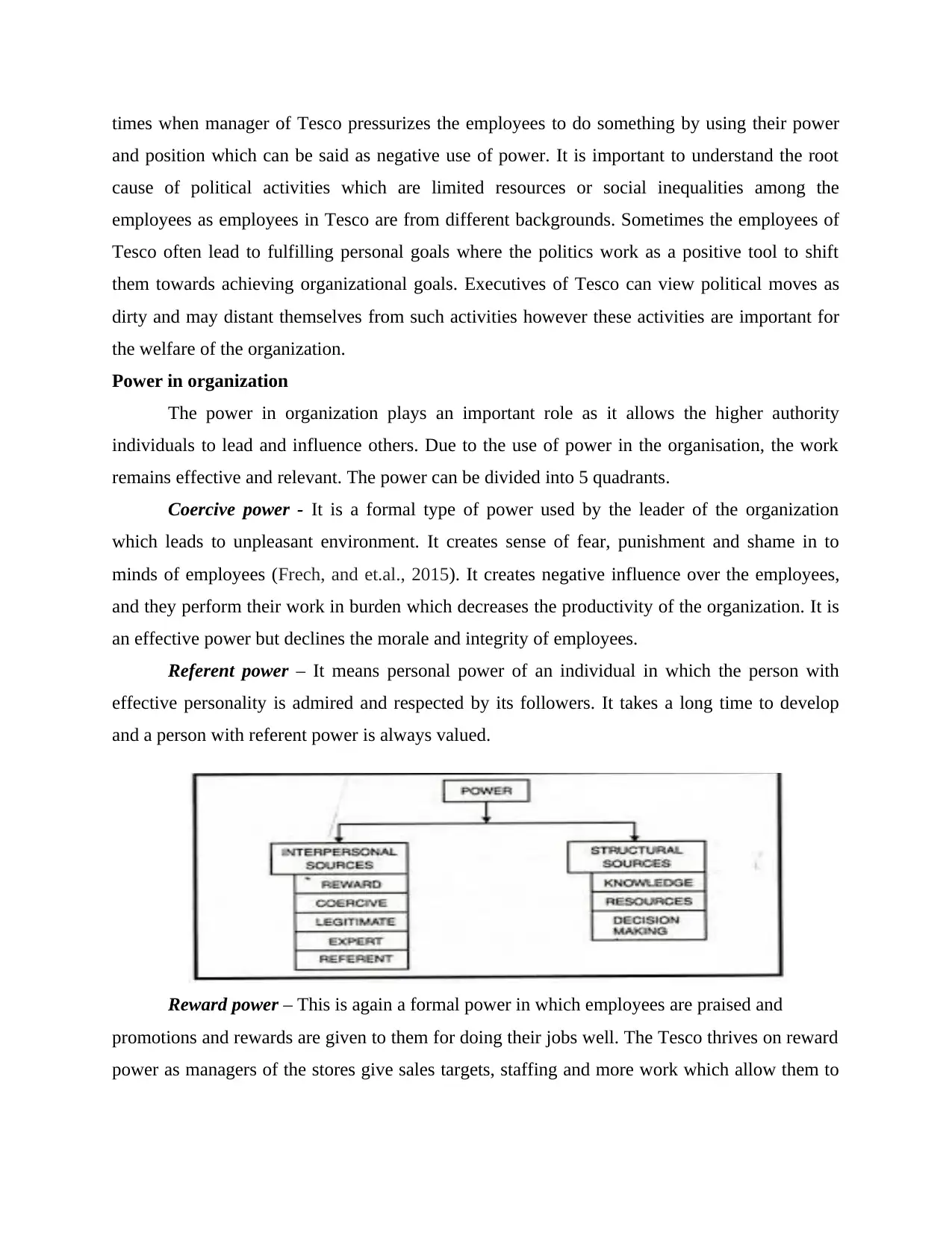
times when manager of Tesco pressurizes the employees to do something by using their power
and position which can be said as negative use of power. It is important to understand the root
cause of political activities which are limited resources or social inequalities among the
employees as employees in Tesco are from different backgrounds. Sometimes the employees of
Tesco often lead to fulfilling personal goals where the politics work as a positive tool to shift
them towards achieving organizational goals. Executives of Tesco can view political moves as
dirty and may distant themselves from such activities however these activities are important for
the welfare of the organization.
Power in organization
The power in organization plays an important role as it allows the higher authority
individuals to lead and influence others. Due to the use of power in the organisation, the work
remains effective and relevant. The power can be divided into 5 quadrants.
Coercive power - It is a formal type of power used by the leader of the organization
which leads to unpleasant environment. It creates sense of fear, punishment and shame in to
minds of employees (Frech, and et.al., 2015). It creates negative influence over the employees,
and they perform their work in burden which decreases the productivity of the organization. It is
an effective power but declines the morale and integrity of employees.
Referent power – It means personal power of an individual in which the person with
effective personality is admired and respected by its followers. It takes a long time to develop
and a person with referent power is always valued.
Reward power – This is again a formal power in which employees are praised and
promotions and rewards are given to them for doing their jobs well. The Tesco thrives on reward
power as managers of the stores give sales targets, staffing and more work which allow them to
and position which can be said as negative use of power. It is important to understand the root
cause of political activities which are limited resources or social inequalities among the
employees as employees in Tesco are from different backgrounds. Sometimes the employees of
Tesco often lead to fulfilling personal goals where the politics work as a positive tool to shift
them towards achieving organizational goals. Executives of Tesco can view political moves as
dirty and may distant themselves from such activities however these activities are important for
the welfare of the organization.
Power in organization
The power in organization plays an important role as it allows the higher authority
individuals to lead and influence others. Due to the use of power in the organisation, the work
remains effective and relevant. The power can be divided into 5 quadrants.
Coercive power - It is a formal type of power used by the leader of the organization
which leads to unpleasant environment. It creates sense of fear, punishment and shame in to
minds of employees (Frech, and et.al., 2015). It creates negative influence over the employees,
and they perform their work in burden which decreases the productivity of the organization. It is
an effective power but declines the morale and integrity of employees.
Referent power – It means personal power of an individual in which the person with
effective personality is admired and respected by its followers. It takes a long time to develop
and a person with referent power is always valued.
Reward power – This is again a formal power in which employees are praised and
promotions and rewards are given to them for doing their jobs well. The Tesco thrives on reward
power as managers of the stores give sales targets, staffing and more work which allow them to
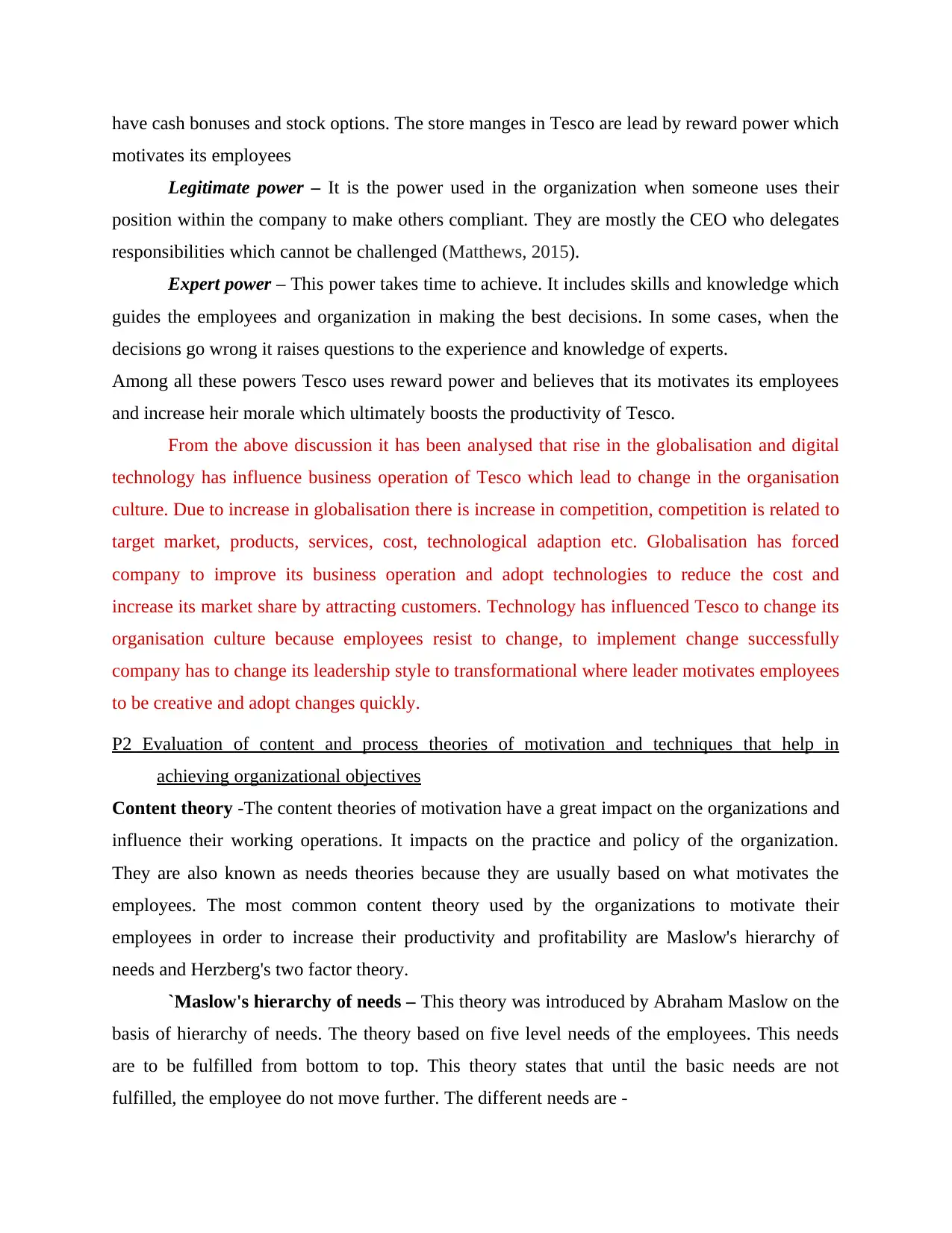
have cash bonuses and stock options. The store manges in Tesco are lead by reward power which
motivates its employees
Legitimate power – It is the power used in the organization when someone uses their
position within the company to make others compliant. They are mostly the CEO who delegates
responsibilities which cannot be challenged (Matthews, 2015).
Expert power – This power takes time to achieve. It includes skills and knowledge which
guides the employees and organization in making the best decisions. In some cases, when the
decisions go wrong it raises questions to the experience and knowledge of experts.
Among all these powers Tesco uses reward power and believes that its motivates its employees
and increase heir morale which ultimately boosts the productivity of Tesco.
From the above discussion it has been analysed that rise in the globalisation and digital
technology has influence business operation of Tesco which lead to change in the organisation
culture. Due to increase in globalisation there is increase in competition, competition is related to
target market, products, services, cost, technological adaption etc. Globalisation has forced
company to improve its business operation and adopt technologies to reduce the cost and
increase its market share by attracting customers. Technology has influenced Tesco to change its
organisation culture because employees resist to change, to implement change successfully
company has to change its leadership style to transformational where leader motivates employees
to be creative and adopt changes quickly.
P2 Evaluation of content and process theories of motivation and techniques that help in
achieving organizational objectives
Content theory -The content theories of motivation have a great impact on the organizations and
influence their working operations. It impacts on the practice and policy of the organization.
They are also known as needs theories because they are usually based on what motivates the
employees. The most common content theory used by the organizations to motivate their
employees in order to increase their productivity and profitability are Maslow's hierarchy of
needs and Herzberg's two factor theory.
`Maslow's hierarchy of needs – This theory was introduced by Abraham Maslow on the
basis of hierarchy of needs. The theory based on five level needs of the employees. This needs
are to be fulfilled from bottom to top. This theory states that until the basic needs are not
fulfilled, the employee do not move further. The different needs are -
motivates its employees
Legitimate power – It is the power used in the organization when someone uses their
position within the company to make others compliant. They are mostly the CEO who delegates
responsibilities which cannot be challenged (Matthews, 2015).
Expert power – This power takes time to achieve. It includes skills and knowledge which
guides the employees and organization in making the best decisions. In some cases, when the
decisions go wrong it raises questions to the experience and knowledge of experts.
Among all these powers Tesco uses reward power and believes that its motivates its employees
and increase heir morale which ultimately boosts the productivity of Tesco.
From the above discussion it has been analysed that rise in the globalisation and digital
technology has influence business operation of Tesco which lead to change in the organisation
culture. Due to increase in globalisation there is increase in competition, competition is related to
target market, products, services, cost, technological adaption etc. Globalisation has forced
company to improve its business operation and adopt technologies to reduce the cost and
increase its market share by attracting customers. Technology has influenced Tesco to change its
organisation culture because employees resist to change, to implement change successfully
company has to change its leadership style to transformational where leader motivates employees
to be creative and adopt changes quickly.
P2 Evaluation of content and process theories of motivation and techniques that help in
achieving organizational objectives
Content theory -The content theories of motivation have a great impact on the organizations and
influence their working operations. It impacts on the practice and policy of the organization.
They are also known as needs theories because they are usually based on what motivates the
employees. The most common content theory used by the organizations to motivate their
employees in order to increase their productivity and profitability are Maslow's hierarchy of
needs and Herzberg's two factor theory.
`Maslow's hierarchy of needs – This theory was introduced by Abraham Maslow on the
basis of hierarchy of needs. The theory based on five level needs of the employees. This needs
are to be fulfilled from bottom to top. This theory states that until the basic needs are not
fulfilled, the employee do not move further. The different needs are -
⊘ This is a preview!⊘
Do you want full access?
Subscribe today to unlock all pages.

Trusted by 1+ million students worldwide
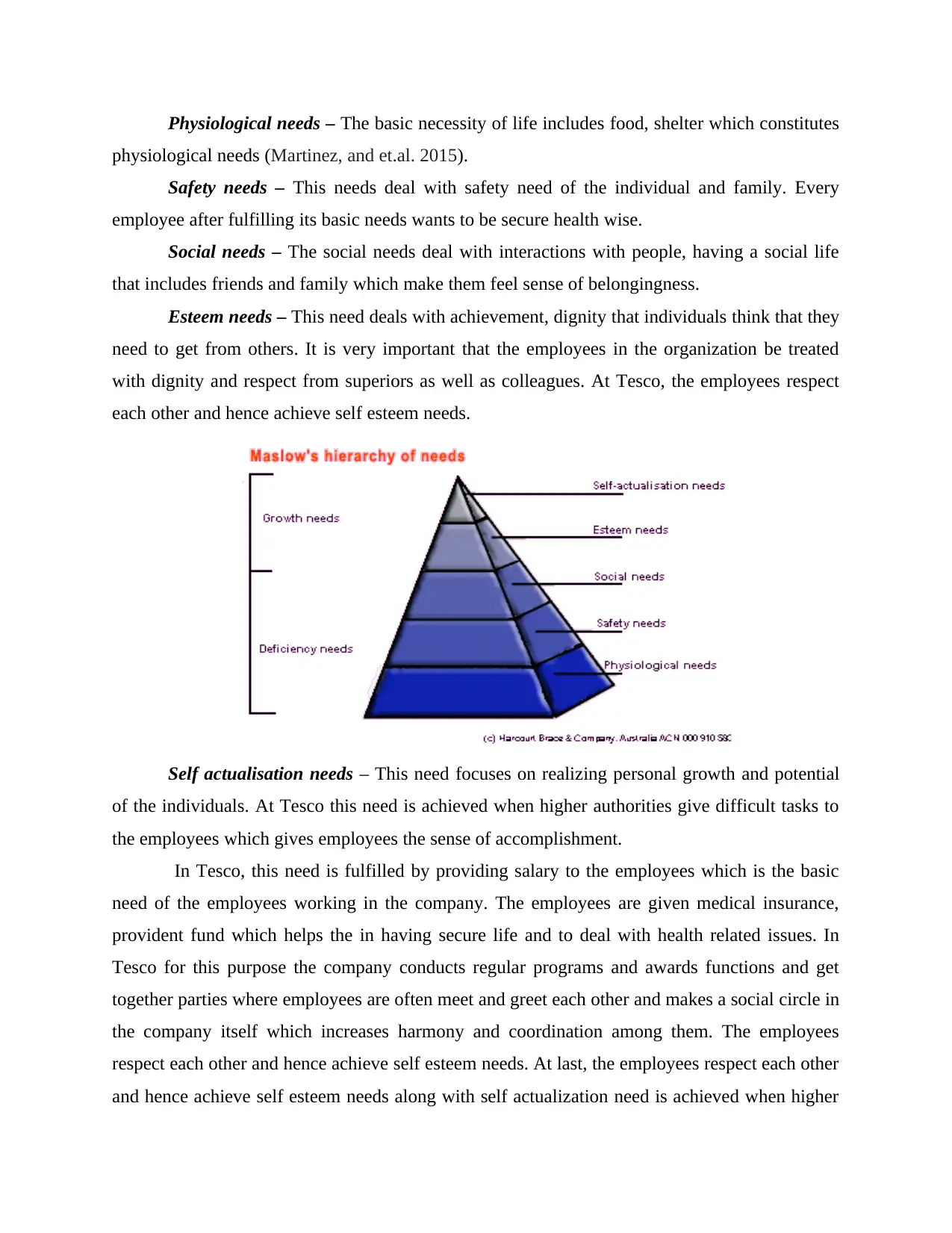
Physiological needs – The basic necessity of life includes food, shelter which constitutes
physiological needs (Martinez, and et.al. 2015).
Safety needs – This needs deal with safety need of the individual and family. Every
employee after fulfilling its basic needs wants to be secure health wise.
Social needs – The social needs deal with interactions with people, having a social life
that includes friends and family which make them feel sense of belongingness.
Esteem needs – This need deals with achievement, dignity that individuals think that they
need to get from others. It is very important that the employees in the organization be treated
with dignity and respect from superiors as well as colleagues. At Tesco, the employees respect
each other and hence achieve self esteem needs.
Self actualisation needs – This need focuses on realizing personal growth and potential
of the individuals. At Tesco this need is achieved when higher authorities give difficult tasks to
the employees which gives employees the sense of accomplishment.
In Tesco, this need is fulfilled by providing salary to the employees which is the basic
need of the employees working in the company. The employees are given medical insurance,
provident fund which helps the in having secure life and to deal with health related issues. In
Tesco for this purpose the company conducts regular programs and awards functions and get
together parties where employees are often meet and greet each other and makes a social circle in
the company itself which increases harmony and coordination among them. The employees
respect each other and hence achieve self esteem needs. At last, the employees respect each other
and hence achieve self esteem needs along with self actualization need is achieved when higher
physiological needs (Martinez, and et.al. 2015).
Safety needs – This needs deal with safety need of the individual and family. Every
employee after fulfilling its basic needs wants to be secure health wise.
Social needs – The social needs deal with interactions with people, having a social life
that includes friends and family which make them feel sense of belongingness.
Esteem needs – This need deals with achievement, dignity that individuals think that they
need to get from others. It is very important that the employees in the organization be treated
with dignity and respect from superiors as well as colleagues. At Tesco, the employees respect
each other and hence achieve self esteem needs.
Self actualisation needs – This need focuses on realizing personal growth and potential
of the individuals. At Tesco this need is achieved when higher authorities give difficult tasks to
the employees which gives employees the sense of accomplishment.
In Tesco, this need is fulfilled by providing salary to the employees which is the basic
need of the employees working in the company. The employees are given medical insurance,
provident fund which helps the in having secure life and to deal with health related issues. In
Tesco for this purpose the company conducts regular programs and awards functions and get
together parties where employees are often meet and greet each other and makes a social circle in
the company itself which increases harmony and coordination among them. The employees
respect each other and hence achieve self esteem needs. At last, the employees respect each other
and hence achieve self esteem needs along with self actualization need is achieved when higher
Paraphrase This Document
Need a fresh take? Get an instant paraphrase of this document with our AI Paraphraser
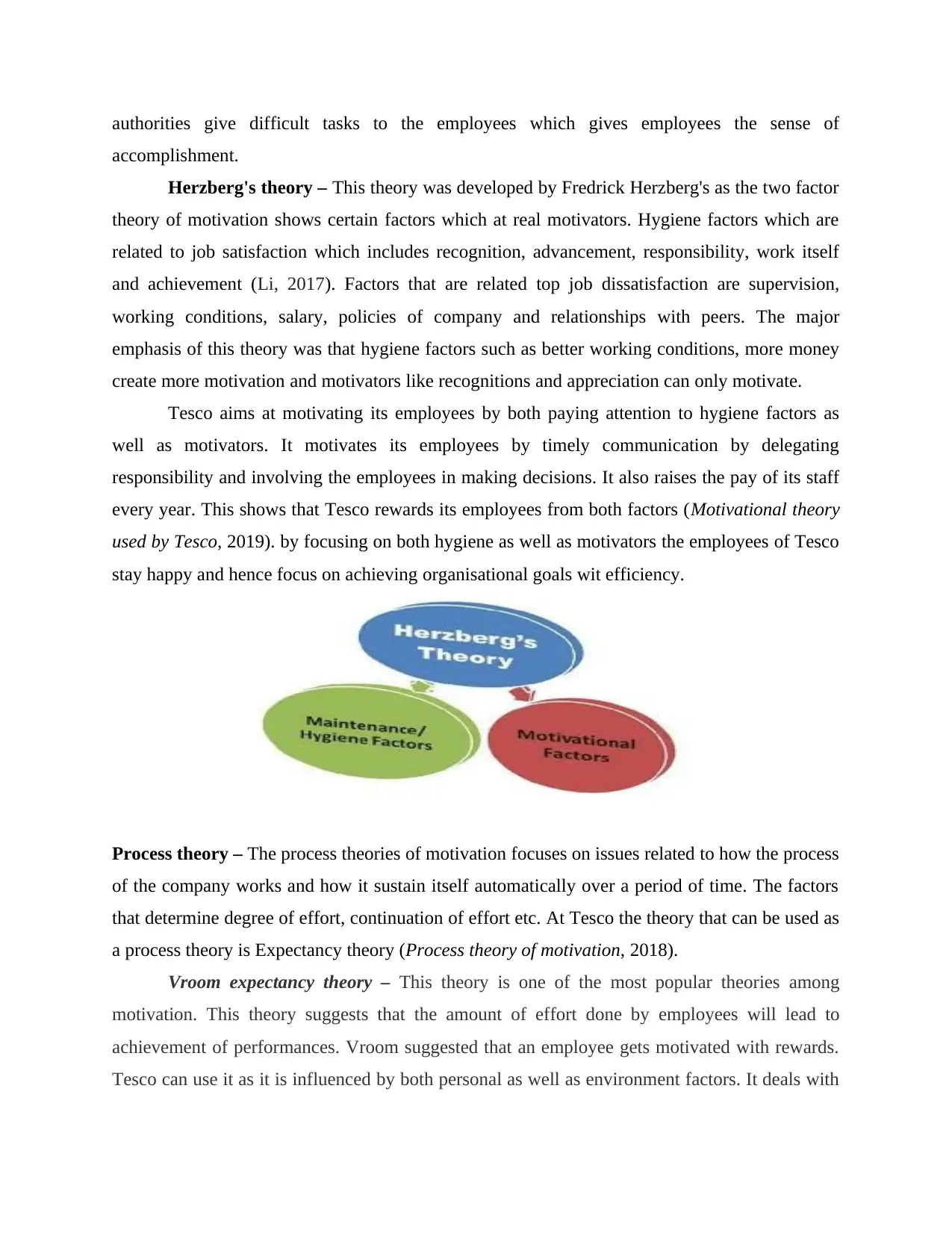
authorities give difficult tasks to the employees which gives employees the sense of
accomplishment.
Herzberg's theory – This theory was developed by Fredrick Herzberg's as the two factor
theory of motivation shows certain factors which at real motivators. Hygiene factors which are
related to job satisfaction which includes recognition, advancement, responsibility, work itself
and achievement (Li, 2017). Factors that are related top job dissatisfaction are supervision,
working conditions, salary, policies of company and relationships with peers. The major
emphasis of this theory was that hygiene factors such as better working conditions, more money
create more motivation and motivators like recognitions and appreciation can only motivate.
Tesco aims at motivating its employees by both paying attention to hygiene factors as
well as motivators. It motivates its employees by timely communication by delegating
responsibility and involving the employees in making decisions. It also raises the pay of its staff
every year. This shows that Tesco rewards its employees from both factors (Motivational theory
used by Tesco, 2019). by focusing on both hygiene as well as motivators the employees of Tesco
stay happy and hence focus on achieving organisational goals wit efficiency.
Process theory – The process theories of motivation focuses on issues related to how the process
of the company works and how it sustain itself automatically over a period of time. The factors
that determine degree of effort, continuation of effort etc. At Tesco the theory that can be used as
a process theory is Expectancy theory (Process theory of motivation, 2018).
Vroom expectancy theory – This theory is one of the most popular theories among
motivation. This theory suggests that the amount of effort done by employees will lead to
achievement of performances. Vroom suggested that an employee gets motivated with rewards.
Tesco can use it as it is influenced by both personal as well as environment factors. It deals with
accomplishment.
Herzberg's theory – This theory was developed by Fredrick Herzberg's as the two factor
theory of motivation shows certain factors which at real motivators. Hygiene factors which are
related to job satisfaction which includes recognition, advancement, responsibility, work itself
and achievement (Li, 2017). Factors that are related top job dissatisfaction are supervision,
working conditions, salary, policies of company and relationships with peers. The major
emphasis of this theory was that hygiene factors such as better working conditions, more money
create more motivation and motivators like recognitions and appreciation can only motivate.
Tesco aims at motivating its employees by both paying attention to hygiene factors as
well as motivators. It motivates its employees by timely communication by delegating
responsibility and involving the employees in making decisions. It also raises the pay of its staff
every year. This shows that Tesco rewards its employees from both factors (Motivational theory
used by Tesco, 2019). by focusing on both hygiene as well as motivators the employees of Tesco
stay happy and hence focus on achieving organisational goals wit efficiency.
Process theory – The process theories of motivation focuses on issues related to how the process
of the company works and how it sustain itself automatically over a period of time. The factors
that determine degree of effort, continuation of effort etc. At Tesco the theory that can be used as
a process theory is Expectancy theory (Process theory of motivation, 2018).
Vroom expectancy theory – This theory is one of the most popular theories among
motivation. This theory suggests that the amount of effort done by employees will lead to
achievement of performances. Vroom suggested that an employee gets motivated with rewards.
Tesco can use it as it is influenced by both personal as well as environment factors. It deals with

three aspects and that is expectancy being the first one is about the skills and ability of
employees to get job done. The more skilful the employee is, the greater and better employee
will perform. The second variable is instrumentality in which the first level results lead to second
level results. It means that higher the employees of Tesco will perform, higher the chances of
getting good outcomes. The final variable is Valence, under which the employee can change
their level of understanding and efforts to complete a job by choosing different behaviour
according to their perceived value about that job. To achieve the goals, Tesco can use this theory
and can apply it by providing more effective training to its employees which will increase their
skills and knowledge.
Extrinsic and intrinsic motivation: Extrinsic motivation is defined as an obligation, reward or
outside demand required for achievement of a specific goal. On the other hand intrinsic
motivation refers to internal motivation for the employee job satisfaction and achievement of
goal. Tesco need to provide both the motivation to employees so that employees are able to gain
fame, money as well as satisfaction in their job.
Emotional intelligence: It refers to the capability to manage and identify an individual's
emotions as well as of the team. Tesco need to take care of the emotions of its employees so that
they feel motivated and work towards achieving business goals. There are 5 characteristics of
emotional intelligence which need to be considered by company which are self-awareness, social
skills, motivation, empathy and self-regulation.
Soft skills of management: Management of company need to have certain soft skills in order to
manage and control the organisation. These skills include communication, leadership skills,
critical thinking, listening, delegating and employee recognition skills. These skills will be
beneficial for Tesco manager in order to control and manage the business. Soft skills benefits
employees to get job done. The more skilful the employee is, the greater and better employee
will perform. The second variable is instrumentality in which the first level results lead to second
level results. It means that higher the employees of Tesco will perform, higher the chances of
getting good outcomes. The final variable is Valence, under which the employee can change
their level of understanding and efforts to complete a job by choosing different behaviour
according to their perceived value about that job. To achieve the goals, Tesco can use this theory
and can apply it by providing more effective training to its employees which will increase their
skills and knowledge.
Extrinsic and intrinsic motivation: Extrinsic motivation is defined as an obligation, reward or
outside demand required for achievement of a specific goal. On the other hand intrinsic
motivation refers to internal motivation for the employee job satisfaction and achievement of
goal. Tesco need to provide both the motivation to employees so that employees are able to gain
fame, money as well as satisfaction in their job.
Emotional intelligence: It refers to the capability to manage and identify an individual's
emotions as well as of the team. Tesco need to take care of the emotions of its employees so that
they feel motivated and work towards achieving business goals. There are 5 characteristics of
emotional intelligence which need to be considered by company which are self-awareness, social
skills, motivation, empathy and self-regulation.
Soft skills of management: Management of company need to have certain soft skills in order to
manage and control the organisation. These skills include communication, leadership skills,
critical thinking, listening, delegating and employee recognition skills. These skills will be
beneficial for Tesco manager in order to control and manage the business. Soft skills benefits
⊘ This is a preview!⊘
Do you want full access?
Subscribe today to unlock all pages.

Trusted by 1+ million students worldwide
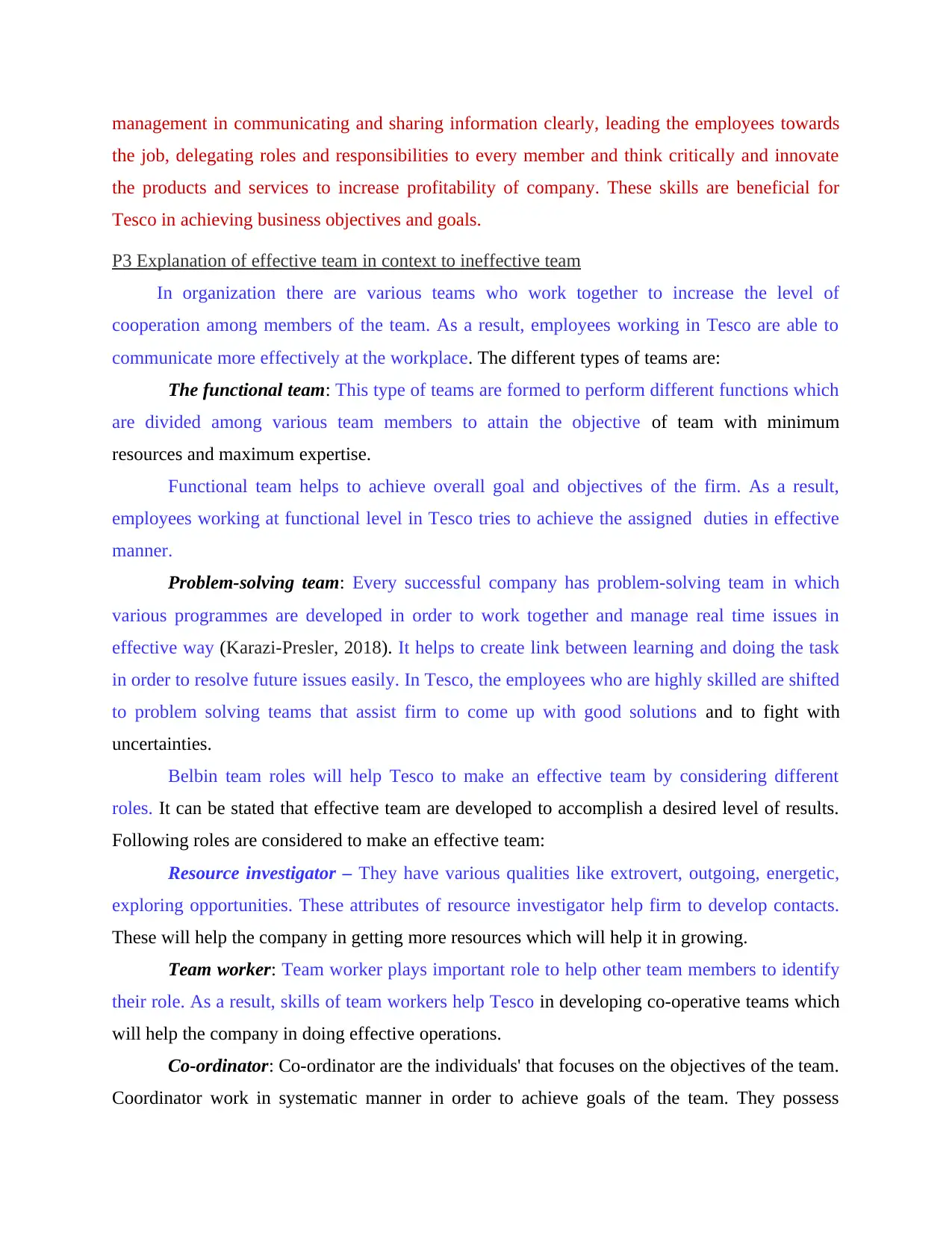
management in communicating and sharing information clearly, leading the employees towards
the job, delegating roles and responsibilities to every member and think critically and innovate
the products and services to increase profitability of company. These skills are beneficial for
Tesco in achieving business objectives and goals.
P3 Explanation of effective team in context to ineffective team
In organization there are various teams who work together to increase the level of
cooperation among members of the team. As a result, employees working in Tesco are able to
communicate more effectively at the workplace. The different types of teams are:
The functional team: This type of teams are formed to perform different functions which
are divided among various team members to attain the objective of team with minimum
resources and maximum expertise.
Functional team helps to achieve overall goal and objectives of the firm. As a result,
employees working at functional level in Tesco tries to achieve the assigned duties in effective
manner.
Problem-solving team: Every successful company has problem-solving team in which
various programmes are developed in order to work together and manage real time issues in
effective way (Karazi-Presler, 2018). It helps to create link between learning and doing the task
in order to resolve future issues easily. In Tesco, the employees who are highly skilled are shifted
to problem solving teams that assist firm to come up with good solutions and to fight with
uncertainties.
Belbin team roles will help Tesco to make an effective team by considering different
roles. It can be stated that effective team are developed to accomplish a desired level of results.
Following roles are considered to make an effective team:
Resource investigator – They have various qualities like extrovert, outgoing, energetic,
exploring opportunities. These attributes of resource investigator help firm to develop contacts.
These will help the company in getting more resources which will help it in growing.
Team worker: Team worker plays important role to help other team members to identify
their role. As a result, skills of team workers help Tesco in developing co-operative teams which
will help the company in doing effective operations.
Co-ordinator: Co-ordinator are the individuals' that focuses on the objectives of the team.
Coordinator work in systematic manner in order to achieve goals of the team. They possess
the job, delegating roles and responsibilities to every member and think critically and innovate
the products and services to increase profitability of company. These skills are beneficial for
Tesco in achieving business objectives and goals.
P3 Explanation of effective team in context to ineffective team
In organization there are various teams who work together to increase the level of
cooperation among members of the team. As a result, employees working in Tesco are able to
communicate more effectively at the workplace. The different types of teams are:
The functional team: This type of teams are formed to perform different functions which
are divided among various team members to attain the objective of team with minimum
resources and maximum expertise.
Functional team helps to achieve overall goal and objectives of the firm. As a result,
employees working at functional level in Tesco tries to achieve the assigned duties in effective
manner.
Problem-solving team: Every successful company has problem-solving team in which
various programmes are developed in order to work together and manage real time issues in
effective way (Karazi-Presler, 2018). It helps to create link between learning and doing the task
in order to resolve future issues easily. In Tesco, the employees who are highly skilled are shifted
to problem solving teams that assist firm to come up with good solutions and to fight with
uncertainties.
Belbin team roles will help Tesco to make an effective team by considering different
roles. It can be stated that effective team are developed to accomplish a desired level of results.
Following roles are considered to make an effective team:
Resource investigator – They have various qualities like extrovert, outgoing, energetic,
exploring opportunities. These attributes of resource investigator help firm to develop contacts.
These will help the company in getting more resources which will help it in growing.
Team worker: Team worker plays important role to help other team members to identify
their role. As a result, skills of team workers help Tesco in developing co-operative teams which
will help the company in doing effective operations.
Co-ordinator: Co-ordinator are the individuals' that focuses on the objectives of the team.
Coordinator work in systematic manner in order to achieve goals of the team. They possess
Paraphrase This Document
Need a fresh take? Get an instant paraphrase of this document with our AI Paraphraser
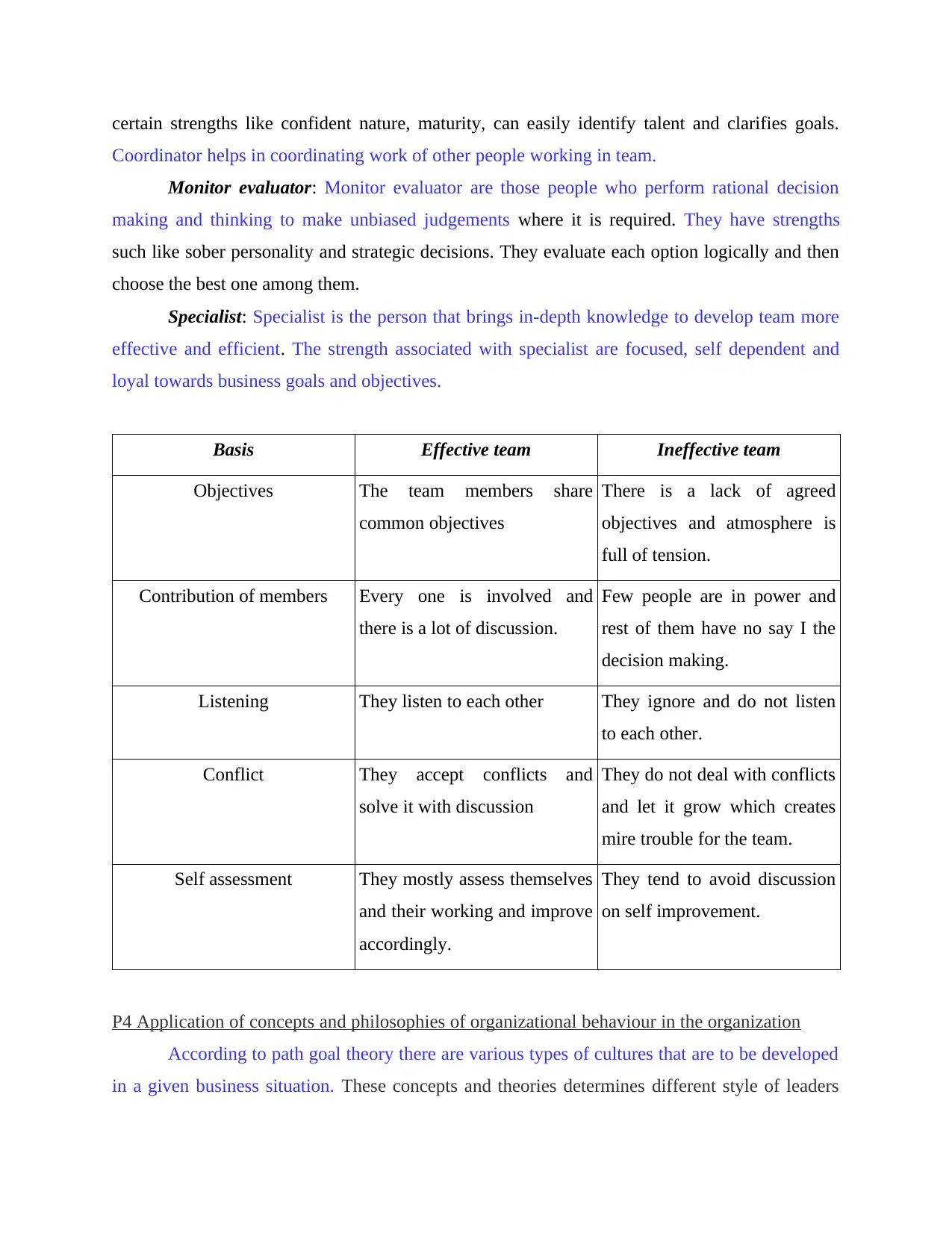
certain strengths like confident nature, maturity, can easily identify talent and clarifies goals.
Coordinator helps in coordinating work of other people working in team.
Monitor evaluator: Monitor evaluator are those people who perform rational decision
making and thinking to make unbiased judgements where it is required. They have strengths
such like sober personality and strategic decisions. They evaluate each option logically and then
choose the best one among them.
Specialist: Specialist is the person that brings in-depth knowledge to develop team more
effective and efficient. The strength associated with specialist are focused, self dependent and
loyal towards business goals and objectives.
Basis Effective team Ineffective team
Objectives The team members share
common objectives
There is a lack of agreed
objectives and atmosphere is
full of tension.
Contribution of members Every one is involved and
there is a lot of discussion.
Few people are in power and
rest of them have no say I the
decision making.
Listening They listen to each other They ignore and do not listen
to each other.
Conflict They accept conflicts and
solve it with discussion
They do not deal with conflicts
and let it grow which creates
mire trouble for the team.
Self assessment They mostly assess themselves
and their working and improve
accordingly.
They tend to avoid discussion
on self improvement.
P4 Application of concepts and philosophies of organizational behaviour in the organization
According to path goal theory there are various types of cultures that are to be developed
in a given business situation. These concepts and theories determines different style of leaders
Coordinator helps in coordinating work of other people working in team.
Monitor evaluator: Monitor evaluator are those people who perform rational decision
making and thinking to make unbiased judgements where it is required. They have strengths
such like sober personality and strategic decisions. They evaluate each option logically and then
choose the best one among them.
Specialist: Specialist is the person that brings in-depth knowledge to develop team more
effective and efficient. The strength associated with specialist are focused, self dependent and
loyal towards business goals and objectives.
Basis Effective team Ineffective team
Objectives The team members share
common objectives
There is a lack of agreed
objectives and atmosphere is
full of tension.
Contribution of members Every one is involved and
there is a lot of discussion.
Few people are in power and
rest of them have no say I the
decision making.
Listening They listen to each other They ignore and do not listen
to each other.
Conflict They accept conflicts and
solve it with discussion
They do not deal with conflicts
and let it grow which creates
mire trouble for the team.
Self assessment They mostly assess themselves
and their working and improve
accordingly.
They tend to avoid discussion
on self improvement.
P4 Application of concepts and philosophies of organizational behaviour in the organization
According to path goal theory there are various types of cultures that are to be developed
in a given business situation. These concepts and theories determines different style of leaders

and their behaviour at workplace that is useful to develop work environment to achieve
objectives of the organization According to the different theories, motivation helps to fulfil
expectations of the leaders through effective work and efforts of the employees.
Motivating workers is one of the most important and essential component in leadership
that play a significant role in increasing productivity of employees as well as organization. In this
context, it can be concluded that goals can be achieved by increasing rewards among the various
staff members. For that purpose, it focuses on providing training and coaching to the employees
so that they can be rewarded for the good work which they will be performing.
Leadership styles that can be followed in the organization
There are different types of styles that leader of the organization may adopt :
Directive: It is one of the four leadership style that focuses on setting clear rules and
objectives for the employees that are working in the organization by ensuring what is expected
from them is clear to the workers. This leadership style is appropriate when employees are
unskilled or inexperienced. They set mission ad visions for the employees and do not receive
feedbacks. Therefore, Leader of Tesco may use this type of leadership at lower level when new
trainees joins the job and do not know their role and this approach can help them in creating
clarity in role expectations. Hence, it is one of the important style that helps employees to receive
guidance and check regularly and is easy to learn.
Supportive: Under this type of leadership style, Leaders are very supportive in nature and
they work together with their employees which focus on their needs, welfare and well-being. It is
same as the people oriented leadership. It focuses on reducing the stress of the employees and
their frustration in the company which I very common these days. This type of leadership is
effective when the tasks performed are dangerous or stressful in nature but in case the tasks are
quite easy then it is not effective as workers do not need to stay motivated. Employer of Tesco
treats their employees with respect and support them in difficulties which is highly important and
useful in situation in which employee faces issue (Omerzel, 2016). Tesco use supportive
leadership when employees are doing over timing and are getting stressed.
Participative: Under participative leadership style, the leader believe in group
performance and group decision-making. The staff of the company gets all the information
related to the issues of the company and company take their votes in order to make any decision.
It sometimes affects the decision-making process and makes it slow. This type of leadership can
objectives of the organization According to the different theories, motivation helps to fulfil
expectations of the leaders through effective work and efforts of the employees.
Motivating workers is one of the most important and essential component in leadership
that play a significant role in increasing productivity of employees as well as organization. In this
context, it can be concluded that goals can be achieved by increasing rewards among the various
staff members. For that purpose, it focuses on providing training and coaching to the employees
so that they can be rewarded for the good work which they will be performing.
Leadership styles that can be followed in the organization
There are different types of styles that leader of the organization may adopt :
Directive: It is one of the four leadership style that focuses on setting clear rules and
objectives for the employees that are working in the organization by ensuring what is expected
from them is clear to the workers. This leadership style is appropriate when employees are
unskilled or inexperienced. They set mission ad visions for the employees and do not receive
feedbacks. Therefore, Leader of Tesco may use this type of leadership at lower level when new
trainees joins the job and do not know their role and this approach can help them in creating
clarity in role expectations. Hence, it is one of the important style that helps employees to receive
guidance and check regularly and is easy to learn.
Supportive: Under this type of leadership style, Leaders are very supportive in nature and
they work together with their employees which focus on their needs, welfare and well-being. It is
same as the people oriented leadership. It focuses on reducing the stress of the employees and
their frustration in the company which I very common these days. This type of leadership is
effective when the tasks performed are dangerous or stressful in nature but in case the tasks are
quite easy then it is not effective as workers do not need to stay motivated. Employer of Tesco
treats their employees with respect and support them in difficulties which is highly important and
useful in situation in which employee faces issue (Omerzel, 2016). Tesco use supportive
leadership when employees are doing over timing and are getting stressed.
Participative: Under participative leadership style, the leader believe in group
performance and group decision-making. The staff of the company gets all the information
related to the issues of the company and company take their votes in order to make any decision.
It sometimes affects the decision-making process and makes it slow. This type of leadership can
⊘ This is a preview!⊘
Do you want full access?
Subscribe today to unlock all pages.

Trusted by 1+ million students worldwide
1 out of 18
Related Documents
Your All-in-One AI-Powered Toolkit for Academic Success.
+13062052269
info@desklib.com
Available 24*7 on WhatsApp / Email
![[object Object]](/_next/static/media/star-bottom.7253800d.svg)
Unlock your academic potential
Copyright © 2020–2025 A2Z Services. All Rights Reserved. Developed and managed by ZUCOL.





